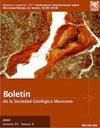Placas columnares de crinoideos de la Formación Las Delicias, Pérmico inferior y medio de Coahuila, México
IF 0.4
4区 地球科学
Q4 GEOLOGY
引用次数: 3
Abstract
Thirteen parataxa of crinoid plates from two localities of the lower-middle Permian of the Las Delicias Formation are described. Both zones are situated in Sierra de las Delicias, to southwestern Coahuila state. The parataxa Pentagonopternix coahuilensis n. sp., Cyclocaudex typicus, C. insaturatus, C. cf. insaturatus, Cyclocaudex sp., Floricyclus diminuta n. sp., Floricyclus sp. Preptopremnum rugosum, P. laeve, Preptopremnum sp., Heterostelechus keithi, Cyclocaudiculus regularis and Epicrinus torreonense new genus and species were found in Las Difuntas locality of the middle Permian (Wordian–Capitanian) whereas Cyclocaudex typicus, C. sp., Preptopremnum laeve and Epicrinus torreonense were also found in Las Sardinas locality whose strata have been dated as early Permian (Kungurian-Roadian). The occurrence of all parataxa in strata from the middle Permian of the Las Delicias Formation allowed extending their stratigraphic range until the Wordian–Capitanian. Most species described have been associated to the Grandian Paleoprovince, nonetheless, the presence of Floricyclus and Pentagonopternix parataxa in the Permian of Coahuila proves the cosmopolitan nature of both genera.墨西哥科阿韦拉下、中二叠纪Las Delicias组海百合柱状板
本文描述了Las Delicias组中下二叠统两个地区的13个海百合类板块副群。这两个地区都位于科阿韦拉州西南部的德拉斯德利西亚斯。在中二叠纪(世界- capitian)的Las Difuntas地区发现了副类群Pentagonopternix coahuilensis n. sp., typicus, C. insaturatus, C. cfinsaturatus, cyococaux sp., Floricyclus diminuta ., Floricyclus sp., pretopremum rugosum, P. laeve, pretopremum sp., Heterostelechus keithi, Cyclocaudiculus regularis和Epicrinus torreonense。在Las Sardinas地区还发现了早二叠世(Kungurian-Roadian)地层的pretopremum lave和Epicrinus torreonense。所有副类群在Las Delicias组中二叠世地层中的出现,使它们的地层范围扩大到世界- capitanian。大多数被描述的物种都与格兰底古省有关,尽管如此,在科阿威拉的二叠纪中出现的Floricyclus和Pentagonopternix parataxa证明了这两个属的世界性。
本文章由计算机程序翻译,如有差异,请以英文原文为准。
求助全文
约1分钟内获得全文
求助全文
来源期刊
CiteScore
1.40
自引率
12.50%
发文量
34
审稿时长
50 weeks
期刊介绍:
The Boletín de la Sociedad Geológica Mexicana is a completely free-access electronic journal published semi-annually that publishes papers and technical notes with its main objective to contribute to an understanding of the geology of Mexico, of its neighbor areas, and of geologically similar areas anywhere on Earth’s crust. Geology has no boundaries so we may publish papers on any area of knowledge that is interesting to our readers.
We also favor the publication of papers on relatively unfamiliar subjects and objectives in mainstream journals, e.g., papers devoted to new methodologies or their improvement, and areas of knowledge that in the past had relatively little attention paid them in Mexican journals, such as urban geology, water management, environmental geology, and ore deposits, among others. Mexico is a land of volcanos, earthquakes, vast resources in minerals and petroleum, and a shortage of water. Consequently, these topics should certainly be of major interest to our readers, our Society, and society in general. Furthermore, the Boletín has been published since 1904; that makes it one of the oldest scientific journals currently active in Mexico and, most notably, its entire contents, from the first issue on, are available online.

 求助内容:
求助内容: 应助结果提醒方式:
应助结果提醒方式:


